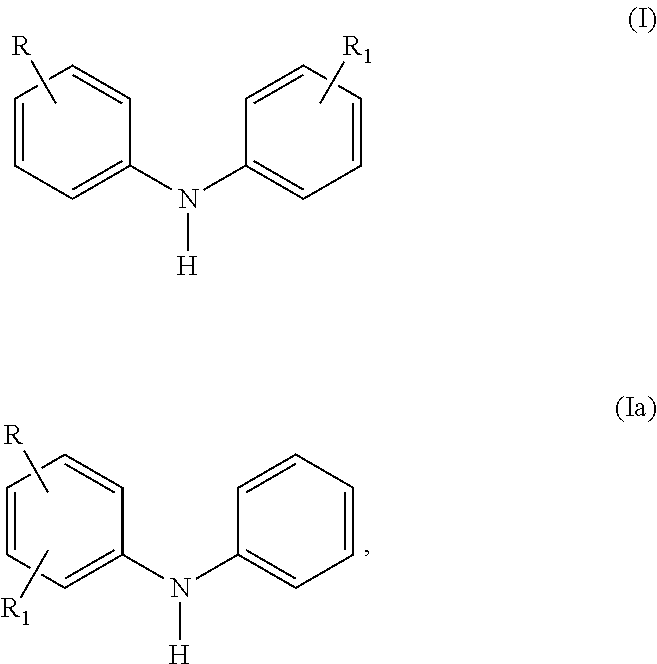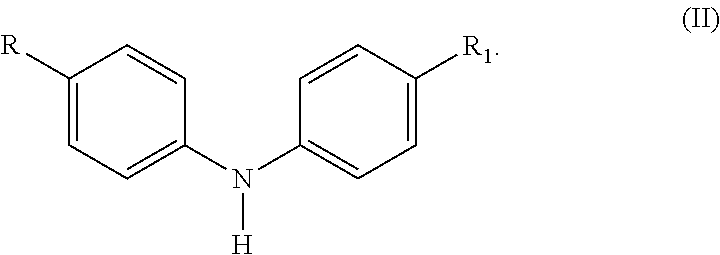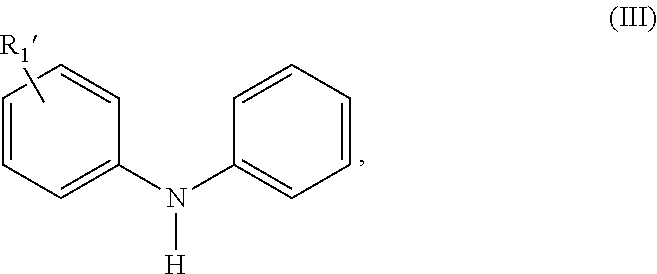Selective Alkylation Method for Producing p, p'-Di-alkylated Diphenylamine Antioxidants
a diphenylamine and antioxidant technology, applied in the field of selective alkylation method for producing p, diphenylated diphenylamine antioxidants, can solve the problems of inability to meet the requirements of the composition, and inability to achieve the reaction of mono-alkylated dpa with styrene or alpha-methylstyrene, etc., to achieve excellent antioxidant activity
- Summary
- Abstract
- Description
- Claims
- Application Information
AI Technical Summary
Benefits of technology
Problems solved by technology
Method used
Image
Examples
example 1
Alkylation of 79%-mono t-Octyl DPA with Nonenes
[0082]Diphenylamine was alkylated with 1.97 equivalents of diisobutylene at 130° C. in the presence of the acidified clay FILTROL 20X to yield after work-up a mixture comprising 79% mono-t-octyl DPA and 17% di-t-octyl DPA.
[0083]A 100 mL three neck flask (equipped with a spiral condenser with nitrogen inlet, overhead stirrer, and thermocouple) was charged with 10.28 grams of the 79% mono-t-octyl DPA above, 6.45 grams of a mixture of nonenes, and 0.514 g freshly crushed AlCl3. The reaction was heated and stirred at 138° C. for 1 hour, then the reaction temperature was increased to 145° C. for 3 hours. An additional 4.4 g nonenes was added in three parts over the next 3.5 hours, the reaction temperature was reduced to 142° C. for 3.5 hours, an additional 0.77 grams of AlCl3 was added and the reaction was stirred at 142° C. for an additional 8hours. An additional 1.5 grams of nonenes was then added, and the reaction was stirred for an addit...
example 2
Alkylation of Diphenylamine with Nonenes
[0084]Diphenylamine was alkylated with 6 equivalents of a mixture of nonenes 138° C. in the presence of AlCl3 to yield after work-up a mixture containing, by gc analysis, 63% p,p′-dinonyl diphenylamine and 27% p-monononyl diphenylamine.
example 3
Alkylation of Diphenylamine with Propylene Tetramer
[0085]A 100 mL three neck flask (equipped with an addition funnel with nitrogen inlet, overhead stirrer, and thermocouple) was charged with 14.39 grams of diphenylamine and 1.5 grams of freshly crushed AlCl3. The addition funnel was charged with 42.42 grams of propylene tetramer. The reaction mixture was heated to 183° C., and the propylene tetramer was added slowly over the course of 5hours. The reaction was stirred at 183° C. for an additional 5 hours. The reaction was worked up according to standard methods, washed, concentrated using a rotary evaporator and sparged at 0.61 torr to 220° C. to yield 24.37 grams of a dark amber liquid containing 39% didodecyl DPA, 32% mono-dodecyl DPA, and 23% tridodecyl DPA.
PUM
| Property | Measurement | Unit |
|---|---|---|
| Fraction | aaaaa | aaaaa |
| Fraction | aaaaa | aaaaa |
| Fraction | aaaaa | aaaaa |
Abstract
Description
Claims
Application Information
 Login to View More
Login to View More - Generate Ideas
- Intellectual Property
- Life Sciences
- Materials
- Tech Scout
- Unparalleled Data Quality
- Higher Quality Content
- 60% Fewer Hallucinations
Browse by: Latest US Patents, China's latest patents, Technical Efficacy Thesaurus, Application Domain, Technology Topic, Popular Technical Reports.
© 2025 PatSnap. All rights reserved.Legal|Privacy policy|Modern Slavery Act Transparency Statement|Sitemap|About US| Contact US: help@patsnap.com



